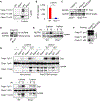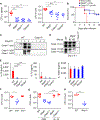The NLRP6 Inflammasome Recognizes Lipoteichoic Acid and Regulates Gram-Positive Pathogen Infection
- PMID: 30392956
- PMCID: PMC6294477
- DOI: 10.1016/j.cell.2018.09.047
The NLRP6 Inflammasome Recognizes Lipoteichoic Acid and Regulates Gram-Positive Pathogen Infection
Abstract
The activator and composition of the NLRP6 inflammasome remain poorly understood. We find that lipoteichoic acid (LTA), a molecule produced by Gram-positive bacteria, binds and activates NLRP6. In response to cytosolic LTA or infection with Listeria monocytogenes, NLRP6 recruited caspase-11 and caspase-1 via the adaptor ASC. NLRP6 activation by LTA induced processing of caspase-11, which promoted caspase-1 activation and interleukin-1β (IL-1β)/IL-18 maturation in macrophages. Nlrp6-/- and Casp11-/- mice were less susceptible to L. monocytogenes infection, which was associated with reduced pathogen loads and impaired IL-18 production. Administration of IL-18 to Nlrp6-/- or Casp11-/- mice restored the susceptibility of mutant mice to L. monocytogenes infection. These results reveal a previously unrecognized innate immunity pathway triggered by cytosolic LTA that is sensed by NLRP6 and exacerbates systemic Gram-positive pathogen infection via the production of IL-18.
Keywords: IL-18; Listeria monocytogenes; NLRP6; caspase-1; caspase-11; gram-positive bacteria; inflammasome; lipoteichoic acid.
Copyright © 2018 Elsevier Inc. All rights reserved.
Conflict of interest statement
COMPETING FINANCIAL INTERESTS
The authors declare no competing financial interests.
Figures







References
-
- Baker PJ, Boucher D, Bierschenk D, Tebartz C, Whitney PG, D’Silva DB, Tanzer MC, Monteleone M, Robertson AA, Cooper MA, et al. (2015). NLRP3 inflammasome activation downstream of cytoplasmic LPS recognition by both caspase-4 and caspase-5. Eur. J. Immunol 45, 2918–2926. - PubMed
-
- Berche P, Gaillard JL, and Richard S (1988). Invasiveness and intracellular growth of Listeria monocytogenes. Infection 16 Suppl 2, S145–148. - PubMed
Publication types
MeSH terms
Substances
Grants and funding
LinkOut - more resources
Full Text Sources
Other Literature Sources
Medical
Molecular Biology Databases
Miscellaneous

